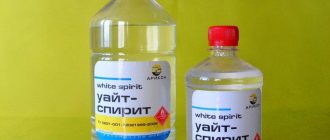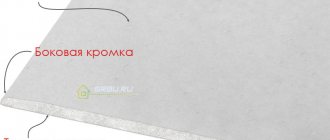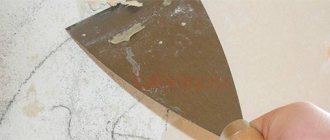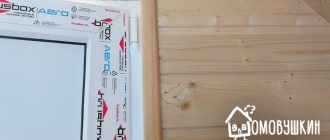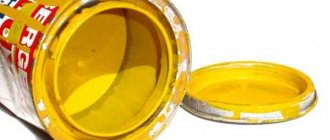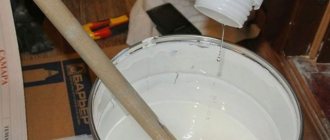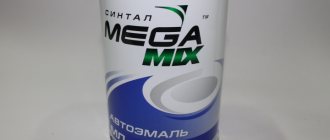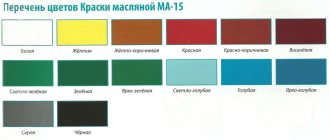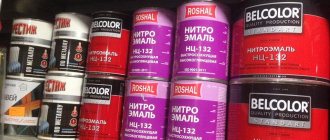Construction work, especially interior decoration, often involves the use of paints and varnishes. However, various enamels and primers often have a viscous consistency, which is not convenient for application. The problem can be solved simply: a solvent is used. In fact, it is an active chemical substance or a multicomponent mixture that has the ability to liquefy viscous substances.
Solvents can be of organic and inorganic origin, but in any case, they are subject to certain requirements prescribed by GOST. In particular, the composition should not enter into chemical interaction with the dye, evaporate quickly and not lose its original properties upon contact with water.
Solvent R-4 fully complies with these standards, but requires more careful consideration.
Where is it used?
Solvent P4 is widely used in construction and repair work.
The reason is the versatility of the product. Therefore, it can be selected for various types of purposes in this field. The most popular addition is the addition of a thinner to paint materials. It was created to dilute vinyl chloride, epoxy, polyvinyl chloride and chlorinated base products. Can be selected for synthetic and natural products that create a film on the coating. Adding a thinner to paint and varnish products can reduce its consumption; the cost of the product is low, so in the end you can significantly save money. Solvent P 4 is also used for other purposes - it can serve as a degreaser for the base, which must be done when finishing the surface, otherwise greasy stains will impair the adhesion of materials.
After cleaning the stain, only a thin film of the substance will remain on the surface; the main elements will evaporate quickly. But the film should not be touched; it will serve as a barrier, improving the quality of painting afterwards.
Adding thinner to paint and varnish products can reduce its consumption.
Thinner number four can clean tools that were used to paint or varnish the base, this will help to reuse them, otherwise you will simply have to throw them away. As a degreasing agent, a solvent may be required not only for painting work; also, some other materials may require preliminary high-quality cleaning, for example, to glue the sole of a shoe.
Thinner number four can clean tools that have been used to paint or varnish substrates.
Manufacturers
Choosing a manufacturer is an important point when purchasing a product, because the composition must be produced within the framework of GOST standards, otherwise the properties will be different, and it will not be possible to speak confidently about the quality of use. In the construction market, there are two proven and popular brands that create high-quality products that meet all required standards.
The first is the Dmitrievsky chemical plant, which has been successfully operating for more than a hundred years. The company selects only the best raw materials for its products, production is carried out taking into account all norms and regulations, and quality checks are carried out at every stage. The company's products are purchased not only in our country, but in 70 other countries.
The company selects only the best raw materials for its products.
The second, the plant is located in Belarus. Also, an enterprise that monitors the quality of its products uses advanced technologies. Produces a variety of compositions for industrial and household use.
An enterprise that monitors the quality of its products uses advanced technologies.
Approximate consumption rates
To determine this parameter, it is necessary to take into account many nuances. In particular:
- Method of applying paintwork materials.
- Air temperature.
- Shelf life of paints and enamels.
- Category of paints and varnishes.
To clarify, let’s consider consumption rates for specific paints and varnishes. It looks like this:
- ХВ 784 (varnish). 50 and 25% for spray and airless application respectively. Please note that such varnishes cannot be applied with a brush.
- XC 010 (primer). 40 and 30% for spraying and airless application.
- PF 115/PF 133 (enamel). The composition is applied with a brush, the consumption rate varies between 12-15%.
- ХВ 124/ХВ 125 (enamel). For compression and airless application, the consumption of the substance is 50-35%, respectively.
If we talk about the total consumption, then paints and varnishes applied by compressor spraying use 2.5 liters of solvent, and the airless method uses 1.75 liters.
Please note that the figures are approximate. When diluting paintwork materials, the solvent is added fractionally, gradually achieving the required consistency.
Calculation of material consumption
To understand how much P4 solvent is required to obtain paint or varnish of the desired consistency, you need to consider several factors. At the same time, it will not be possible to say exactly the volume of expenses; each case is individual; this level is influenced by the density of the material, its type and brand. Manufacturers indicate on the packaging the average diluent consumption per square meter of surface.
Deviations from this figure depend on the following points:
- The method of applying paint, brushes and rollers differ in consumption; using a spray gun will also require a different amount of composition;
- Temperature indicators in the room, the warmer the room, the faster the stage of evaporation of the constituent components of the substance passes, the consumption is higher;
- How long was the paint stored?
- Type of paint material.
Standard thinner consumption to create the optimal consistency of certain types of paint and varnish products in kg/l:
- Varnish XB784, thinner will require half the volume of varnish if a spray is used, and a quarter of the volume if brushes or a roller;
- Primer solution XC010, 40% for mechanical application, 30% for manual application;
- Enamel PF115/PF – 13-15% when working with brushes;
- Enamel ХВ124/ХВ requires 50% thinners when using the spraying technique, 35% when manually applied to the surface.
You should not add too much P4, otherwise the properties of the paint and varnish material will suffer.
Solvent P 4 consumption per 1 m2 for degreasing cannot be said exactly, in this case it all depends on the size of the surface, the product is simply soaked on a suitable sponge and the greasy stain is wiped with it. But it is important to be careful not to damage the base.
You should not add too much P4, otherwise the properties of the paint and varnish material will suffer.
ENVIRONMENTAL REQUIREMENTS
7.1. Solvent production produces liquid or gaseous wastes that can cause air and water pollution.
7.2. In order to protect atmospheric air from pollution, they monitor compliance with maximum permissible emissions (MPE) in accordance with GOST 17.2.3.02 in the manner established by the relevant executive authority.
7.3. In order to protect the environment from pollution by wastewater, monitoring of compliance with maximum permissible concentrations and estimated safe levels of exposure to harmful substances in the water of fishery reservoirs is organized.
7.4. All liquid waste in the form of contaminated solvents is returned to production or sent to treatment facilities.
7.5. Solvent waste is neutralized by collecting it and then recycling it for reuse. Section 7. (Introduced additionally, Amendment No. 5). Appendix. (Excluded, Amendment No. 4).
6. SAFETY REQUIREMENTS
6.1. Solvents of grades R-4, R-4A, R-5, R-5A, R-12 are flammable liquids with a characteristic odor that have a strong irritant effect on the skin, mucous membrane of the eyes and upper respiratory tract. Possible routes of entry of harmful substances into the body: inhalation and through the skin. Monitoring the content of harmful substances in the air at the workplace - in accordance with GOST 12.1.005. Determination of the content of harmful substances in the air of the working area is carried out according to methods developed in accordance with GOST 12.1.005 and GOST 12.1.016 and approved by health authorities. Work related to the production and use of solvents must comply with current sanitary rules and regulations*. ________________ * The list of regulatory documents in force in the Russian Federation is presented in Appendix 1.
6.2. Production, testing and use of solvents must comply with the requirements of GOST 12.1.004, GOST 12.3.002 and GOST 12.3.005.
6.3. The main fire hazard characteristics of solvents of grades R-4, R-4A, R-5, R-5A, R-12 are presented in Table 3. Table 3
| Solvent brand | Self-ignition temperature, °C | Temperature limits of flame propagation, °C | |
| Lower | Upper | ||
| R-4 | 550 | Minus 10 | 19 |
| R-4A | 520 | Minus 8 | 11 |
| R-5 | 513 | Minus 12 | 4 |
| R-5A | 497 | Minus 3 | 24 |
| R-12 | 490 | 5 | 36 |
The main characteristics of the fire hazard and toxicity of solvents included in the solvent grades R-4, R-4A, R-5, R-5A, R-12 are presented in Table 4. Table 4
| Fire characteristics | ||||||||
| Solvent name | Hazard class according to GOST 12.1.005 | Maximum permissible concentration (MPC) of vapors in the air of the working area, mg/m3, according to GOST 12.1.005 | Temperature, °C | Temperature limits of flame propagation, °C | ||||
| closed cup flashes | open crucible flashes | ignition | self-ignition | Nizhny | Upper | |||
| Acetone | IV | 200 | Minus 20 | Minus 9 | Minus 5 | 535 | Minus 20 | 6 |
| Toluene | III | 50 | 4 | 5 | — | 536 | 6 | 37 |
| Xylene | III | 50 | 29 | — | — | 590 | 24 | 50 |
| Butyl acetate | IV | 200 | 29 | 35 | 35 | 330 | 22 | 61 |
6.4. Persons associated with the production and use of solvents must be provided with special clothing and personal protective equipment in accordance with GOST 12.4.011 and GOST 12.4.068.
6.5. The production and use of solvents is carried out in rooms equipped with local and general supply and exhaust ventilation in accordance with GOST 12.4.021.
6.6. When solvents catch fire, fire extinguishing agents are used: felt felt, sand, foam fire extinguishers, foam installations, finely sprayed water, carbon dioxide. Section 6. (Changed edition, Amendment No. 5).
Features and composition
Any solvent either belongs to a group of active chemicals or is a mixture of several components. This mixture of substances of organic origin is P-4.
It appears as a clear, colorless or yellowish liquid with no sediment or suspended particles. The substance has a sharp characteristic odor.
It has gained great popularity because it has good consumer properties. P-4 is sold in any specialized store at an affordable price. Moreover, with a wide range of applications, it is very easy to use. A description of the method of use and composition are usually indicated in the instructions located on the container with the substance.
One of the features of R-4 is the ability to use it for diluting almost any paint and varnish materials, making their use economical. And also P-4 gives them the ability to dry faster, and when dry it forms a smooth, shiny film that prevents the coating from fading.
Care must be taken to ensure that no water gets into the solvent during operation. It will mix with the acetone and cause white spots to appear on the painted surface once it dries.
Acetone and toluene are required ingredients in the solvent. There are 26 and 62% of them in R-4, respectively. They expand the scope of its application. And also butyl acetate is added to the composition, which helps protect painted surfaces from fading.
However, these substances cannot be called beneficial for the human body. Although contact with the solvent on the skin does not cause burns, prolonged contact with it and inhalation of vapors will not pass without a trace: poisoning, dizziness, coughing, and dermatitis may occur.
micron solvent, micron solvent Suppliers and Manufacturers on Alibaba.com
-Excellent color vibrancy, extended gamut and consistent color density with excellent wash fastness and durability, and resistance to dry and wet dishes. - Eco-Friendly Odorless Galaxy Solvent Ink for Printer DX4 DX5 DX7 3. High Printing Efficiency Printing with ultra-fine dot pattern for maximum ink printing on finished fabric. - Eco-Friendly Odorless Galaxy Solvent Ink for DX4 DX5 DX7 Printer 4. Cost Effective Optimize the performance of your printers while reducing overall production costs.
2, this brand Limei galaxy pheaton a-starjet wit-color gongzheng jet best eco-solvent ink is specially designed for dx4 dx5 dx7 printer head, high quality printing. The best eco-solvent ink Gongzheng Jet brand Limei galaxy pheaton a-starjet wit-color has good fluidity, wide color gamut, bright colors and high resistance to climatic conditions. - Limei brand galaxy pheaton a-starjet wit-color gongzheng jet best eco-solvent ink 4. Cost-effective Optimize the performance of your printers while reducing overall production costs.
.
INFORMATION DATA
1. DEVELOPED AND INTRODUCED by the USSR Ministry of Chemical Industry
DEVELOPERS
A.I. Nepomnyashchy, K.G. Sulimova, O.G. Kurbatova
2 APPROVED AND ENTERED INTO EFFECT by Resolution of the State Committee of Standards of the Council of Ministers of the USSR dated April 15, 1974 No. 889
3 Inspection frequency - 5 years
4 INSTEAD GOST 7827-55
5 REFERENCED REGULATIVE AND TECHNICAL DOCUMENTS
| Designation of the referenced technical document | Number of paragraph, subparagraph | Designation of the referenced technical document | Number of paragraph, subparagraph |
| GOST 12.1.004-91 | 6.2 | GOST 1770-74 | 3.2.1 |
| GOST 12.1.005-88 | 6.1,6.3 | GOST 4220-75 | 3.2.1 |
| GOST 12.1.016-79 | 6.1 | GOST 5105-82 | 4.1 |
| GOST 12.1.044-89 | 1.3 | GOST 5799-78 | 4.1 |
| GOST 12.3.002-75 | 6.2 | GOST 6128-81 | 4.1 |
| GOST 12.3.005-75 | 6.2 | GOST 6247-79 | 4.1 |
| GOST 12.4.011-89 | 6.4 | GOST 6507-90 | 3.7.1, 3.7.4 |
| GOST 12.4.021-75 | 6.5 | GOST 6613-86 | 3.7.1, 3.7.3 |
| GOST 12.4.068-79 | 6.4 | GOST 9980.1-86 | 2.1 |
| GOST 17.2.3.02-78 | 7.2 | GOST 9980.2-86 | 3.1 |
| GOST 9980.3-86 | 4.1 | GOST 23955-80 | 1.3, 3.5 |
| GOST 9980.4-2002 | 4.2 | GOST 24104-2001 | 3.6.1 |
| GOST 9980.5-86 | 4.3 | GOST 25336-82 | 3.5, 3.6.1 |
| GOST 13950-91 | 4.1 | GOST 26319-84 | 4.1 |
| GOST 14192-96 | 4.2 | GOST 28498-90 | 3.4.1 |
| GOST 14870-77 | 1.3, 3.3 | GOST 29227-91 | 3.5 |
| GOST 16523-97 | 3.7.1, 3.7.4 | GOST 29251-91 | 3.4.1, 3.6.1 |
| GOST 18300-87 | 3.6.1 | GOST 30765-2001 | 4.1 |
| GOST 19433-88 | 4.2 | GOST 30766-2001 | 4.1 |
| GOST 21029-75 | 4.1 | GOST 31089-2003 | 1.2 |
(New edition.
Amendment No. 5 ).
9. Validity period extended until 01/01/95 by Decree of the USSR State Standard of 12/20/88 No. 4324
designer solvent mixtures | Hansen solubility parameters
As discussed below, a mixture of two solvents can often have better solubility properties (lower HSP distance) than either of the individual solvents, which may not even be solvents for the target materials.
With this app you can try out these ideas. Select the target polymer, then the different solvent pairs and vary their ratios until you get the best match (smallest HSP or Ra distance):
Solvent mixtures
Acetone [15.5, 10.4, 7] Acetonitrile [15.3, 18, 6.1] Benzyl alcohol [18.4, 6.3, 13.7] 1-Butanol [16, 5.7, 15.8 ] 2-Butanol [15.8, 5.7, 14.5] n-Butyl acetate [15.8, 3.7, 6.3] Cyclohexane [16.8, 0, 0.2] Cyclohexanol [17.4 , 4.1, 13.5] Cyclohexanone [17.8, 8.4, 5.1] Diacetone alcohol [15.8, 8.2, 10.8] N, N-dimethylacetamide [16.8, 11, 5, 10.2] N, N-dimethylformamide (DMF) [17.4, 13.7, 11.3] Dimethyl sulfoxide (DMSO) [18.4, 16.4, 10.2] 1,4-Dioxane [ 17.5, 1.8, 9] Ethanol [15.8, 8.8, 19.4] Ethyl acetate [15.8, 5.3, 7.2] Ethylbenzene [17.8, 0.6, 1.4] Ethyl lactate [16, 7.6, 12.5] Ethylene carbonate [18, 21.7, 5.1] Ethylene glycol [17, 11, 26] Ethylene glycol monobutyl ether [16, 5.1, 12.3] Ethylene glycol monomethyl ether [16, 8.2, 15] gamma-butyrolactone (GBL) [18, 16.6, 7.4] heptane [15.3, 0, 0] hexane [14.9, 0, 0] isobutanol [15.1, 5 .7, 15.9] isopropyl acetate [14.9, 4.5, 8.2] Isophorone [17, 8, 5] d-Limonene [17.2, 1.8, 4.3] Methanol [14.7 , 12.3, 22.3] Methyl acetate [15.5, 7.2, 7.6] Methyl ethyl ketone (MEK) [16, 9, 5.1] N-Methyl-2-pyrrolidone (NMP) [18, 12.3, 7 ,2] methylene chloride [17, 7.3, 7.1] 1-nitropropane [16.6, 12.3, 5.5] 2-propanol [15.8, 6.1, 16.4] 1-propanol [16, 6.8, 17.4] n-propyl acetate [15.3, 4.3, 7.6] Propylene carbonate [20, 18, 4.1] PG Monobutyl ether [15.3, 4.5, 9.2] PG Monoethyl ether acetate [15.6, 6.3, 7.7] PG Monomethyl ether [15.6, 6.3, 11.6] PG Monomethyl ether acetate [15.6, 5.6, 9.8] Tetrahydrofuran (THF) [16.8, 5. 7, 8] Toluene [18, 1.4, 2] Water [15.5, 16, 42.3] Xylene [17.6, 1, 3.1] Oxygen [14.7, 0, 0] Radon [ 17.2, 0, 0] Acetone [15.5, 10.4, 7] Acetonitrile [15.3, 18, 6.1] Benzyl alcohol [18.4, 6.3, 13.7] 1-Butanol [16, 5 .7, 15.8] 2-Butanol [15.8, 5.7, 14.5] n-Butyl acetate [15.8, 3.7, 6.3] Cyclohexane [16.8, 0, 0.2 ] Cyclohexanol [17.4, 4.1, 13.5] Cyclohexanone [17.8, 8.4, 5.1] Diacetone alcohol [15.8, 8.2, 10.8] N, N-dimethylacetamide [ 16.8, 11.5, 10.2] N, N-dimethylformamide (DMF) [17.4, 13.7, 11.3] Dimethyl sulfoxide (DMSO) [18.4, 16.4, 10.2] 1,4-Dioxane [17.5, 1.8, 9] Ethanol [15.8, 8.8, 19.4] Ethyl acetate [15.8, 5.3, 7.2] Ethylbenzene [17.8, 0. 6, 1.4] Ethyl lactate [16, 7.6, 12.5] Ethylene carbonate [18, 21.7, 5.1] Ethylene glycol [17, 11, 26] Ethylene glycol monobutyl ether [16, 5.1, 12.3] Ethylene glycol monomethyl ether [16, 8.2, 15] gamma-butyrolactone (GBL) [18, 16.6, 7.4] heptane [15.3, 0, 0] hexane [14.9, 0, 0] isobutanol [15.1, 5.7, 15.9] isopropyl acetate [14.9, 4.5, 8.2] Isophorone [17, 8, 5] d-Limonene [17.2, 1.8, 4.3 ] Methanol [14.7, 12.3, 22.3] Methyl acetate [15.5, 7.2, 7.6] Methyl ethyl ketone (MEK) [16, 9, 5.1] N-Methyl-2-pyrrolidone (NMP) [18, 12.3, 7.2] methylene chloride [17, 7.3, 7.1] 1-nitropropane [16.6, 12.3, 5.5] 2-propanol [15.8, 6.1, 16 ,4] 1-propanol [16, 6.8, 17.4] n-propyl acetate [15.3, 4.3, 7.6] Propylene carbonate [20, 18, 4.1] PG Monobutyl ether [15.3, 4.5, 9.2] PG Monoethyl acetate ether [15.6, 6.3, 7.7] PG Monomethyl ether [15.6, 6.3, 11.6] PG Monomethyl ether acetate [15.6, 5.6, 9.8] Tetrahydrofuran (THF) [ 16.8, 5.7, 8] Toluene [18, 1.4, 2] Water [15.5, 16, 42.3] Xylene [17.6, 1, 3.1] Oxygen [14.7, 0, 0] Radon [17.2, 0, 0] Polyethylene (PE) [16.9, 0.8, 2.8] Polypropylene (PP) [18, 0, 1] Polystyrene (PS) [18.5, 4.5 , 2.9] Polyvinyl chloride (PVC) [19.2, 7.9, 3.4] Polyacrylonitrile (PAN) [22.4, 14.1, 9.1] Polymethyl methacrylate (PMMA) [18.6, 10, 5, 5.1] Polyethyl methacrylate (PEMA) [17.6, 9.7, 4] Polycarbonate (PC) [18.2, 5.9, 6.9] Polycaprolactone [17.7, 5, 8.4] Polyvinyl acetate (PVA) [17.6, 2.2, 4] Nylon 66 [17.4, 9.9, 14.6] PET [18.2, 6.4, 6.6] Epoxy [17.4, 10.5, 9] Polyvinyl butyral [18.6, 4.4, 13] Polyvinylidene fluoride (PVF) [17, 12.1, 10.2] Polyphenylene oxide (PPO) [17.9, 3.1, 8.5] Polyurethane (PU) [18.1 , 9.3, 4.5] Polysulfone [16, 6, 6.6] Polysilicone [17.2, 3, 3] Polyethersulfone [19, 11, 8] Polyoxymethylene (PON) [17.2, 9.2, 9.8] Polyvinylpyrrolidone (PVP) [17.5, 8, 15 ] Cyclic olefin copolymer (COC) [18, 3, 2] Polyethylene oxide (PEO, PEG) [17, 10, 5] Polypropylene oxide (PPO, PPG) [16.5, 9, 7] Polyvinyl alcohol (PVOH) [15, 17, 2, 17.8] Ethylene vinyl alcohol (EVOH) [15.5, 13, 13] Polylactic acid (PLA) [18.6, 9.9, 6]
When Charles first presented his HSP scheme, he saw that it makes a surprising prediction. Two bad solvents (blue dots in the image) on opposite sides of an HSP sphere should produce an excellent solvent (green dot in the center) when mixed 50:50. If his HSP ideas are wrong, then mixing two bad solvents will result in another bad solvent. When he ran a test, his ideas were confirmed - you really can make a good solvent from a mixture of bad ones.
This is probably the most useful idea in the entire HSP. This gives formulators amazing freedom to combine solvents that are attractive in terms of cost, safety, odor, volatility, etc., but which are poor solvents for a particular system, and create an excellent solvent mixture. By judiciously manipulating the relative volatility of solvents, it is possible to create mixtures that deliberately destroy solutes when evaporation begins (the best solvent is more volatile), or destroy one solute component (its best solvent is more volatile) or, alternatively, to create an ultra-smooth finish, ensuring that the best solvent for a critical component is the least volatile, so it must remain in solution until the last moment.
For those who want a little more power, download HSP_Calculations.xlsx, which allows you to optimize in Excel. HSPiP's Solvent Optimizer is an ideal tool for those with complex requirements, such as automatically selecting the top three solvents from a list.
.
Solvent P 4
Composition and properties
P 4 is an organic solvent that contains aromatic hydrocarbons, ketones and ethers. It consists of 62% toluene, 26% acetone, 12% butyl acetate. The mixture of these components effectively dissolves and liquefies various paints, varnishes, resins and other organic substances.
There is a variety of it - solvent R-4a, the peculiarity of which is the absence of butyl acetate in the composition.
This product is produced in accordance with GOST 7827-74. R-4 GOST is produced with the following technical characteristics:
- looks like a transparent liquid without color or yellowish, without suspension (P-4 and P-4a look the same);
- water content - 0.7%;
- volatility - from 5 to 15;
- acid number, mg KOH/g - no more than 0.07;
- coagulation number - not less than 24%.
Application
This product is used to dilute and dissolve varnishes, putties, enamels, primers, paints marked XB, XC, XSL, EP, Vinicolor, Vinikor, Evicor, Evinal, primer-enamel XC-500.
R-4 is also used for washing dishes, hands and arms after working with paints and varnishes.
This solvent is suitable for dissolving and liquefying enamels, varnishes, primers and putties marked XC, XV, PCV, MS, EP-0020, except for XB-124 gray and protective enamel. Modification of this solvent R-4a can also dissolve gray and protective enamel XB-124.
It is volatile, which is what its use is based on: after adding a solvent to the paint and applying it to the surface, it quickly hardens and forms a film.
Important! Do not allow water to get into solvents R-4 and R-4a. This will lead to whitening of the paint film, since water mixes easily with acetone, which is part of the product.
Safety
Solvent R 4 is toxic, fire and explosive, so when working with it, you must follow safety precautions.
- The composition must be stored in fireproof ventilated areas, away from sunlight, in sealed containers;
- It is also necessary to work with solvent in rooms with good ventilation;
- avoid contact with eyes;
- work with protective gloves, avoid contact with skin, in case of contact with skin, wash off with plenty of warm water and soap.
Due to the fire hazard of the solvent, sparks, open fire, and smoking must be excluded in the room where it is stored and work is carried out. In case of fire, P-4 is extinguished using foam, carbon dioxide, and sprayed water. It should be remembered that vapors of the solvent and its components (butyl acetate, acetone, toluene) are heavier than air, can accumulate near the floor and are explosive.
The toxicity of the drug is manifested by narcotic effects (dizziness, headache, disorientation, clouding of consciousness with prolonged inhalation), irritation of the eyes and other mucous membranes, cough. Inhalation of vapors for a long time may result in poisoning similar in symptoms to food poisoning and toxic damage to the nervous system.
Therefore, when working with solvents, you should use protective equipment (goggles, gloves, respirator), and work only in a well-ventilated area. If the product gets on the skin, it must be washed off; if it gets into the eyes, rinse them and seek medical help.
Solvent grades R-4 and R-4a are also fire and explosive, form explosive compounds with acids and oxidizing agents (acetic, nitric acid, hydrogen peroxide), react with chloroform and bromoform, the reaction products are fire and explosive. They are aggressive against some types of plastic.
Solvent grade P4
Quite often, for painting work, a P4 solvent is used, which contains acetone, toluene and butyl acetate. As a rule, this brand is used for diluting varnishes and paints, dissolving synthetic and natural film-forming compounds, for bringing materials and other compounds to the required thickness and, less often, for cleaning dishes, tools and hands.
Technical characteristics of P4 solvent
Solvent grade P4 is defined by GOST as a mixture of acetone (26%), butyl acetate (12%) and toluene (26%). The thinning composition can be used with most enamels and varnishes, including those based on chloride resins. The presence of butyl acetate in the thinner prevents fading of the paintwork and improves its shine.
Like all solvents, grade P4 is explosive and highly flammable. Since the vapors of butyl acetate, toluene and acetone are heavier than air, they tend to accumulate at the bottom of the room, and their high concentration is quite explosive. Therefore, when using such mixtures, compliance with fire safety is required for working with flammable and explosive substances. To extinguish thinning compounds, it is recommended to use fire extinguishers with chemical and air-mechanical foam, and finely dispersed water.
Analogues that can be replaced
This type of diluent has analogues. If you can’t find exactly this type, then you can consider the following means, which is quite possible to replace the P4 solvent:
- Solvent P 4a is the closest option in composition to P4. The main difference between them is that 4a does not contain butyl acetate, which makes its use somewhat wider; it can be used for paint and varnish products of the XB124 type;
- P5/P 5a, suitable for a larger number of paints and varnishes, due to a different ratio of the main components in the composition; toluene and butyl acetate are added here in smaller quantities. For this reason, they can be used for products with rubber, silicone elements, and also with polyacrylic resin as a base;
- P12 in this case, xylene is used instead of acetone, this makes the ability to spontaneously combust faster, the process occurs at high temperatures of +490 degrees. Widely used in car painting work, it helps thin car enamels and remove the old paint layer on the car surface.
But it should be remembered that the composition is universal, but there are exceptions that should not be combined with it. Some chemical elements can combine to form an explosive mixture, hydrogen peroxide, acetic and nitric acid. Should not be used to coat plastic substrates.
Thinner type P4 is a good option to save paint and varnish material by giving it the desired consistency
When working, it is important to act carefully so as not to spoil the material. It is also necessary to create favorable conditions for use in order to eliminate the risk of fire and human poisoning when inhaling volatile substances.
What is the difference between solvent 646 and 647
When choosing a solvent composition, it is sometimes difficult to determine the specific type, since there are currently numerous types of thinner on the market - 646, 647, 648, and so on. In order to choose the right type of composition, you should know its characteristics and effect on a specific material. The most common are the compositions of two brands - 646 and 647, and in order to understand their differences it is necessary to understand their main characteristics. Since we have already become familiar with solvent 646, we will consider grade 647.
Solvent 647 can be purchased at any building materials store or on the market in any quantity. This liquefier is purchased not only by specialized enterprises, but also by ordinary consumers for household needs. The mixture is packaged both in 0.5 liter bottles and in large containers for production needs.
The main difference between solvent grades 646 and 647 is the chemical composition. If brand 646 contains ethanol, butanol, toluene, acetone and ethyl cellosolve, then 647 contains butyl acetate, toluene, ethyl acetate and butanol. Despite the similarity of compositions, solvent 647 does not contain acetone, which makes it less aggressive towards delicate surfaces. At the same time, when working with solvent 646, you must be extremely careful and attentive so as not to damage the paint layer. This is due to the fact that this composition is classified as a highly active solution.
Grade 647 is used for diluting nitrocellulose and paints and varnishes, giving them the necessary viscosity. Using solvent 647 you can quite efficiently remove various marks from the surface.
Specifications
Solvent R-4 is a volatile, self-igniting substance. However, spontaneous combustion occurs at a fairly high temperature - above 500 degrees C
However, it is flammable and must be handled with care. You should not smoke near it; open fire and sparks are not allowed.
One important indicator to consider is the flash point. This term refers to the temperature at which solvent vapor mixed with air vapor ignites in the presence of an open fire. For R-4, the flash point is -7 degrees C.
During production, the substance is packaged in containers whose walls will not react chemically with it. This is usually glass or plastic packaging. The solvent should be stored in dark rooms with good ventilation so that it is not exposed to direct sunlight and moisture. The container must be tightly closed, and there should be no electrical or heating devices nearby.
The technical characteristics of the solvent are determined by GOST standards. They are usually indicated on the packaging. For R-4 it is:
- coagulation number – 24%;
- part of water – 0.7%;
- volatility – 5-15;
- density – 0.85 m3;
- ignition temperature – 550 degrees C;
- flash point – minus 7 degrees C.
Solvent packaging can be small or large. It depends on where it will be used.
For household use, it goes on sale in containers of 0.5, 1, 3, 5,10, 20 liters. In a bottle with a capacity of 0.5 liters, the weight of the product will be 0.4 kg. In other containers - 0.7, 2.2, 3.7, 7.2, 14 kg according to the indicated volumes.
For industrial use, large packaging is used. It can be 100 or 216 liters. In it, the weight of the product will be 72 and 165 kg, respectively.
Transportation and storage
For storage, the solvent should be packaged only in narrow-neck containers: canister, bottle, drum made of glass or polymer materials. Closures must ensure complete tightness, as well as be resistant to the action of the solvent itself.
R-4 is stored in a dark place away from heating devices and sources of fire. Shelf life – 1 year from the date of production. Solvents are transported by rail or road transport in compliance with measures for the transportation of dangerous goods of class 3.
Transportation of solvent in barrels
Analogs
If it happens that all the solvent has run out, and the nearest store does not have R-4, then the problem is minor.
You can finish the job using its analogues.
First of all, pay attention to the P-4A. It has the same properties as P-4; it is its closest analogue. They have similar composition and areas of application. It differs from R-4 in the absence of butyl acetate. Thanks to this fact, R-4A can be used with XB-124 brand enamel. You can replace the R-4 with the R-5 or R-5A. They have a slightly wider scope of application. They can be used for materials based on rubber, silicone, and polyacrylic resins. R-5 contains 40% toluene and 30% each of butyl acetate and acetone. And also a “relative” of R-4 is the solvent R-12. It differs from R-4 in that it does not contain acetone, it is replaced with xylene. It has a lower ignition temperature. It is 490 degrees C
R-12 should be used with caution if other substances are used for the job. The fact is that when mixed with some (hydrogen peroxide, acetic or nitric acid), it is capable of forming explosive mixtures.
R-12 is suitable for working with various types of paints and varnishes, with film-forming substances. It is widely used in car repair shops, where they are used to paint car enamels. It can also be used to remove old acrylic paint from cars. To do this, moisten the paint with the product and wait 10-15 minutes, and then remove the softened layer with a spatula. R-12 is used in everyday life for cleaning tools and removing stains. It should be noted that R-12 is aggressive to some types of plastics.
Solvent R-4 can be replaced with other brands
Here you need to pay attention to the composition and technical characteristics. If the compositions of paints and varnishes and solvents are incompatible, then their components may coagulate or separate
To select compatible formulations, it is better to seek advice from a specialist.
For more information about solvent R-12, see the video below.
Specifications
You can buy p-4 solvent wholesale from the manufacturer based on the following ratio of substances:
- Toluene – 62%.
- Acetone – 26%.
- Butyl acetate – 12%.
R-4 solvents from the manufacturer are highly flammable, so when working with them it is important to follow safety requirements. For our part, we guarantee to ensure maximum safety of the composition during its transportation and storage, since improper handling can lead not only to the loss of basic characteristics, but also cause more serious problems
Scope of application
The p-4 solvent from the manufacturer is suitable for solving the following list of tasks:
- Dilution of paints and varnishes based on chlorinated polyvinyl chloride resins.
- Effective dissolution of materials.
- Preparing the surface for applying a new paint layer.
- Removing liquid nails from various types of surfaces.
- Bringing the paint consistency to working consistency.
A large amount of toluene in the composition allows the solvent to remove all types of paint.
Where to buy solvent r-4
The product belongs to the category of universal and easily accessible, so we are ready to provide it at an affordable price in the required volume.
You can buy R-4 solvent wholesale at an affordable price in the following packaging options:
- PET 0.5 l.
- Tech. bottle 0.5 l.
- PET 1 l.
- Kan. 1 l.
- Kan. 3 l.
- Kan. 5 l.
- Kan. 10 l.
Favorable prices for R-4 solvent are one of the main advantages of our company.
Security measures
Compliance with safety measures is the main point that you need to pay attention to if you decide to buy p-4 solvents in bulk. The use of the composition, like other chemicals, can only be carried out in a well-ventilated area
For storage, on the contrary, it is better to choose a dark and dry area, protected from children and pets. With prolonged contact with the composition, nausea, dizziness, vomiting, and severe poisoning may occur.
Selling high-quality solvents is the main direction of our company. We deliver throughout Russia in hermetically sealed containers and are ready to answer all your questions when placing an order. We deal only with large wholesale with a wide profile of companies.
Shipping and payment
By road and rail transport
Form of payment - cashless payment
Wide range of packaging: from bottle to tanker
Pickup of products from the warehouse is possible
Application table
| Lucky | Enamels | Primers | Putties |
| XC-76 | XB-16 | ХВ-062 | ХВ-004 |
| XC-724 | XB-112 | ХВ-079 | ХВ-005 |
| XB-124 | XC-010 | EP-0020 | |
| XB-125 | XC-059 | ||
| ХВ-142 | XC-068 | ||
| XB-179 | XC-077 | ||
| ХВ-518 | MS-067 | ||
| XB-519 | |||
| XB-553 | |||
| XB-714 | |||
| XB-750 | |||
| XB-782 | |||
| XB-1100 | |||
| XB-785 | |||
| ХВ-1120 | |||
| XB-1149 | |||
| XB-5169 | |||
| XC-119 | |||
| XC-527 | |||
| XC-710 | |||
| XC-717 | |||
| XC-720 | |||
| XC-724 | |||
| XC-747 | |||
| XC-748 | |||
| XC-759 | |||
| XC-781 | |||
| XC-5163 | |||
| PVC-29 | |||
| PVC-101 |
Scope of application
The solvent is ideal for thinning enamels based on polyvinyl chloride resins, epoxy resins, vinyl chloride copolymers and some other film formers. Such enamels include XB-16, XB-112, XC-748, XC-759 and many others, with the exception of gray and protective enamels XB-124.
Using a solvent, you can give the desired consistency to the following repair materials:
- varnishes NTs-269, NTs-279, NTs-292, NTs-5108, EP-524;
- putties NTs-007, NTs-008, NTs-009, EP-0010, EP-0020;
- soils XC 059/068/077, MS 067, XB 062/079.
Polyvinyl chloride enamel XB-16
Suitability for diluting a huge amount of materials makes R-4 very popular in the construction and finishing industry.
Important! It can undoubtedly be called a universal composition for synthetic and natural paints and varnishes.
The solvent can act as a degreaser, allowing you to quickly and completely remove greasy stains that reduce the adhesion of the base to the finish. It evaporates instantly, leaving behind only the thinnest film that does not need to be removed. R-4 helps to get rid of stains of various types of adhesives, clean painting tools, after which they can be reused.
Method of use
The solvent is added to the base material in small portions and mixed well until the consistency of the paintwork material becomes optimal. It is important that no water gets into the liquid during operation, since acetone quickly mixes with it, as a result, the color of the finished paint film may be distorted.
Removing old paint
To remove grease and dirt, wipe the surface with a cloth soaked in solvent. To clean old paint, the base is generously moistened with P-4, left for a while, after which the paint is quickly and easily removed with a spatula.
Safety precautions at work
The composition contains toxic elements, for this reason the work requires compliance with safety rules. Prolonged inhalation of diluent vapors can lead to harmful effects on the body. To avoid having to call a doctor after using the product, the room is provided with high-quality ventilation for the entire period of application.
The master must work in rubber gloves, also wear a respirator, preferably wearing safety glasses. If solvent gets on your skin, immediately wash the area with soap. First aid for dizziness and feeling nauseous is to drink plenty of water to clear the stomach, and seek medical help. There should be no open sources of fire near the liquid, the substance is flammable.
If solvent gets on your skin, immediately wash the area with soap.
